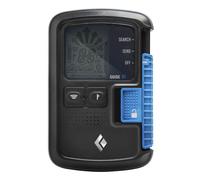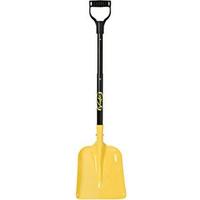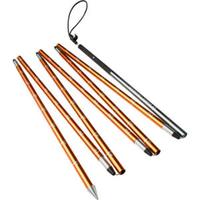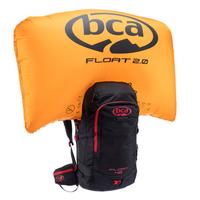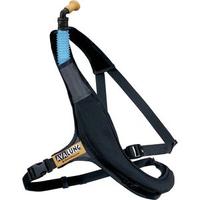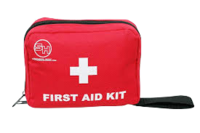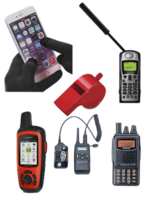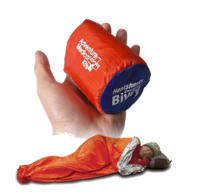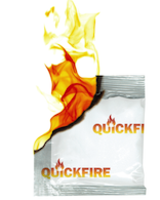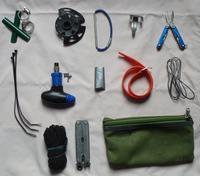Carry the right gear, and know how to use it. For additional information on avalanche rescue gear, check out the Utah Avalanche Center's Know Before You Go Get the Gear and Get the Training eLearning modules.
Need to buy gear? Want to help the Utah Avalanche Center at the same time? Buy your gear using the links from our Affiliate Sales page and the Utah Avalanche Center gets a percentage of all purchases. Remember, you must link to the retail sites through the Utah Avalanche Center Affiliate Sales page or the links below to apply their donation.
Essential Rescue Gear
Avalanche Transceiver
Avalanche rescue beacons (also called transceivers) have proven to be the only reliable way to locate a completely buried victim in time to save their life. Each person wears a transmitting beacon, and if someone is buried, the surviving members turn their beacons to receive and they can quickly locate the buried victim. Several companies manufacture avalanche beacons and they all operate on the same frequency. The technologies they use vary from being completely analog to completely digital, with some operating in a digital/analog mix. Each brand, and the technology they use, have their strong and weak points. Check out BeaconReviews.com for the latest articles and reviews on this rapidly-changing technology. And most important, practice often with your beacon. The pros practices at least once per week. Always wear your beacon under your jacket, never in your pack. When you put it on, turn it on. When you take it off, turn it off.
Avalanche Shovel
Everyone needs a shovel, not only to dig out a buried victim (avalanche debris is very dense and hard) but to dig snowpits to assess the snowpack stability and even to dig out your car or snowmobile when it gets stuck. Modern shovels are constructed out of strong lightweight aluminum. Plastic shovels, shovels without a handle, and blades smaller than 8 inches by 8 inches (20 x 20 cm) are not recommended.
Avalanche Probe
An avalanche beacon will put you over a buried avalanche victim, but digging in dense avalanche debris is often very time consuming, so it's essential to get an exact location. That's where probes come in. Also, probes are the only way to find a victim who was either not wearing a beacon or wearing an inoperable beacon. Probes come in different lengths with 270cm being a popular recreational length and the minimum you should consider. They are made of aluminum or carbon, and have a screw or quick clamp fitting to lock the sections in place. Assemble probes like tent poles, toss the sections out on the ground and shake the pole sections while gently pulling the tension cable at the top.
Backpack
A lightweight, comfortable pack is a key element to carry you backcountry gear. Many packs also have features that allow you to organize your gear for convenient access. Packs are available that will carry just the basics like your shovel, probe, repair and first aid kits, and extra clothing up to multi day packs that carry a large volume of gear. Many packs also have features like external shovel pockets and hydration systems as well. A quality pack will also have a waist and sternum strap to keep the load secure during athletic activities. Packs are available with a built in Avalung.
Recommended Gear
Airbag Pack
Admit it. When you go to a party, you gently shake the bowl of potato chips so that the largest ones rise to the surface. Similarly, larger objects tend to rise to the surface of avalanche debris. By pulling a rip cord, the avalanche air bag in your pack adds 150 liters or more to your volume. Used for over ten years in Europe, the statistics are impressive, roughly doubling your chances of surviving an avalanche. The air bag system is now available in North America and it is rapidly gaining popularity. As prices and weight continue to drop, the air bag will most likely become standard equipment for all backcountry travelers.
AvaLung
Be honest. How fast can your friends dig you out? Most completely-buried avalanche victims only have about 15 minutes to live under the snow, but an AvaLung can increase that time up to an hour. Along with a beacon, the AvaLung is an important piece of life-saving equipment. The AvaLung (in a vest, a over-the-chest sling, or build into a pack) offers critical oxygen intake that buys you precious time while buried under snow. Designed to extract air from the snow, it works to redirect carbon dioxide away from your oxygen-intake zone, reducing ice masking and CO2 poisoning of your oxygen supply.
An Avalung can be either a stand-alone unit (shown) or incorporated into a pack.

Helmet
A good helmet should be warm, comfortable, and will give your brain some protection from trauma. For best protection, look for EN 1077 Class B (Alpine Ski) certification. The ideal solution is a helmet meeting both EN 1077 Class B and UIAA 106 or EN 12492 (Mountaineering) certification to provide lightweight protection and comfort
Optional, But Recommended Gear

Warm Clothes
Staying warm while you wait for help, care for an injured partner, or make your way back to the trailhead after losing key gear can be hard. If help is more than a few minutes away, a spare puffy jacket, beanie, and mittens belong in your pack.
First Aid Kit
It's common to get injured, sometime seriously, or killed by the violence of the avalanche even if you don't get buried. A first aid kit and knowing how to use it can save a life. The first aid kit you carry will depend on your level of training, how far you are from help, and your group. At a minimum, you should be able to perform CPR and control simple trauma like bleeding and broken bones. American Alpine Institute has a great recommendation for first aid kits.
Shelter
If your partner is injured and can't move, you'll need get them warm and keep them that way. And you need to keep yourself warm. Consider a small, lightweight Emergency Bivy such as the Sol Emergency Bivy. These weigh almost nothing, take up very little space in your pack and could be a lifesaver.
Repair Kit
An often overlooked, but critical piece of backcountry safety equipment is your repair kit. Whether skiing, splitboarding, snowshoeing, snowmobiling, or snowbiking, try post-holing chest deep several miles back to your car in the dark if you break a piece of gear and can't fix it. For skiers and splitboarders, San Juan Mountain Guides has put together a great list of basic equipment to consider carrying. For motorized users, My Snowmobile Guide has a great list of recommended equipment to carry.


